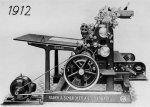O.K., here's the deal. I've been a pressman for 25 years, have run everything from a Multi-1250, to a 40" 2-color Harris, to a few Heidelberg GTOs and KORDs, to a variety of 4, 5 and 6 color Komori Lithrones. Right now, I'm running a full-auto Komori L-628, with perfector, coater, scanner...the whole works. It's now 5 years old, and I've been the lead on the second shift for 4 1/2 of those years. We are a fairly high-end commercial printer and run typical stocks, usually ranging from 60 lb coated on the thin side, to 16pt on the heavy side. We rarely run anything outside of that range. On all presses in this shop, and on every other press at every other shop I've ever worked in, we NEVER regularly adjusted the swing arm gripper clearance unless the stock was something truly exceptional, like onionskin or board stock. And we never, ever, had a problem using the "standard" setting.
Until recently, that is. The swing arm on the 628 started making soft clacking noises, and while we tried to identify an exact cause of the noise, and made the obvious attempts at adjustment, we couldn't eliminate the noise. The swing arm eventually stopped accepting sheets properly. We had to call Komori in to investigate. They said we needed to replace the gripper pads and cam follower. They made the repairs, and solved the problem. They also said we were supposed to adjust the clearance setting for any stock thicker than 80lb/0.004. This means we get to move the press to the proper position, get out the wrench, and make the adjustment on basically every job we run. We go back and forth between 80lb and 100lb all the time - which are on opposite sides of the standard setting. We never once did that before (either in this shop or in any of the others) and the swing arm on this press ran problem free for 5 WHOLE YEARS.
My questions are: What's your take on this, do you adjust the swing arm clearance setting on your press daily? And, what's wrong with setting it for ample clearance and leaving it there, if it works for the jobs you're running? I realize some jobs or stocks may require a careful adjustment of the clearance setting for a wide variety of reasons, but Komori is apparently implying that we somehow damaged the gripper pads and cam follower by regularly running the gap too tight for the stock. I was taught (and I've seen it myself, firsthand) that the press will let you know instantly if the setting is too tight, by either damaging the sheet, causing mis-register, or bouncing the sheet out from the headstops entirely. How could I be wrong about this, after 25 years of experience? And how bad could a "too tight" setting be, if it took 5 years of 24hr/6-day run time to develop any problem whatsoever?
Any advice or comments?
Until recently, that is. The swing arm on the 628 started making soft clacking noises, and while we tried to identify an exact cause of the noise, and made the obvious attempts at adjustment, we couldn't eliminate the noise. The swing arm eventually stopped accepting sheets properly. We had to call Komori in to investigate. They said we needed to replace the gripper pads and cam follower. They made the repairs, and solved the problem. They also said we were supposed to adjust the clearance setting for any stock thicker than 80lb/0.004. This means we get to move the press to the proper position, get out the wrench, and make the adjustment on basically every job we run. We go back and forth between 80lb and 100lb all the time - which are on opposite sides of the standard setting. We never once did that before (either in this shop or in any of the others) and the swing arm on this press ran problem free for 5 WHOLE YEARS.
My questions are: What's your take on this, do you adjust the swing arm clearance setting on your press daily? And, what's wrong with setting it for ample clearance and leaving it there, if it works for the jobs you're running? I realize some jobs or stocks may require a careful adjustment of the clearance setting for a wide variety of reasons, but Komori is apparently implying that we somehow damaged the gripper pads and cam follower by regularly running the gap too tight for the stock. I was taught (and I've seen it myself, firsthand) that the press will let you know instantly if the setting is too tight, by either damaging the sheet, causing mis-register, or bouncing the sheet out from the headstops entirely. How could I be wrong about this, after 25 years of experience? And how bad could a "too tight" setting be, if it took 5 years of 24hr/6-day run time to develop any problem whatsoever?
Any advice or comments?














